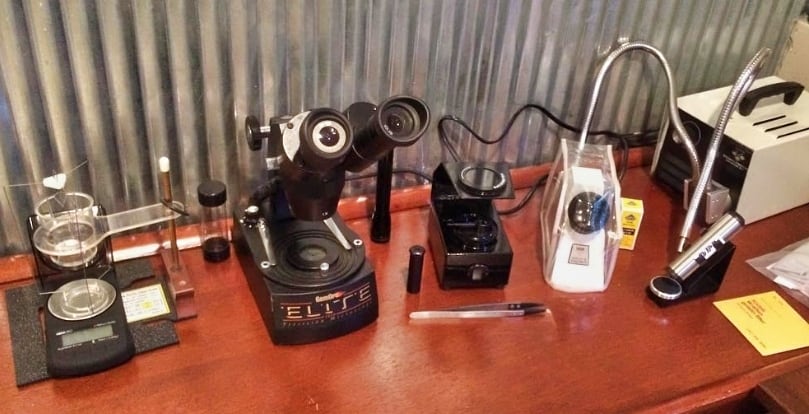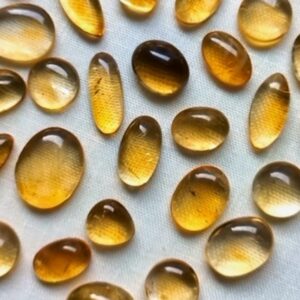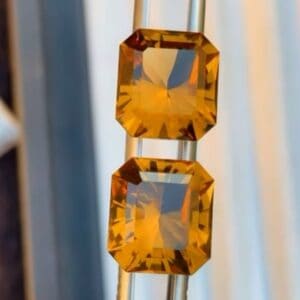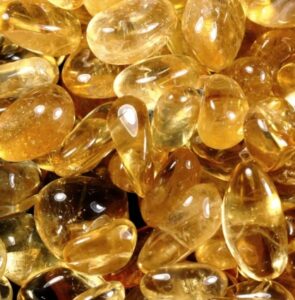Citrine is very common and you’ll see it at every jewelry store and rock and mineral show. Most of the time you’ll find citrine crystals and clusters being sold by deals while the jewelers sell faceted versions and cabochons fashioned into trendy jewelry.
Due to it being fairly inexpensive, citrine is worn and collected by most rockhounds and crystal enthusiasts.

How to Identify Citrine Through Testing
There are various ways to identify rocks, minerals, crystals, and gemstones, but we will be using a method I learned while attending the Gemological Institute of America. If you’ve learned a unique way to identify gemstones then feel free to share it with us.
Let’s look deeper into how to identify citrine like a pro.
Visual Inspection
The visual inspection starts with what form of citrine you have. The questions below are fairly easy to answer, but each type will have its own process for identifying them.

Is it a cabochon? If you’re dealing with a cabochon, then it should have a medium to high polish with very little pitting on the surface. The inclusions create a beautiful array of whitish and soft grey hues. You’ll also find higher-quality pieces with no inclusions used in rings and pendants.
While citrine cabochons are popular in jewelry, it’s rarely seen in high-end fashion. Beaded bracelets and necklaces are fairly common and crystal collectors will use them during affirmations.

Is it faceted? If you have a faceted piece of citrine, then it should be transparent with colors ranging from light yellow to very dark orange with red flashes, known as Madeira citrine. As you can see from the high-quality faceted citrine above, high saturation with a deep orange color is the most sought-after.
When inspecting the stone you’ll want to use a 10x powered loop to scan for internal inclusions. Citrine will have feathers and clouds but most stones will have a high clarity rating. Keep in mind yellow scapolite and heliodor looks identical to citrine but it lacks high saturation when it comes to color.

Is it a specimen? Citrine is found in different forms, and you’ll get better at identifying these forms by looking at and inspecting this mineral over time. Here’s a list of characteristics citrine displays when it’s a specimen.
- Pale to rich-yellow-orange colors
- Translucent – transparent
- Large clusters are common
- Sceptor crystals are sought after

Is it tumbled? Very common to find tumbled citrine. It will have a smooth, glossy shine.
Physical Properties of Citrine
Let’s take a look at the physical properties of citrine. Knowing what to look for will help you more easily identify what you’re looking at.
Color: Pale yellow to deep orange – sometimes zoned
Clarity / Transparency: Transparent to Translucent
Luster: Vitreous
Cleavage: None
Fracture: Conchoidal
The Streak Test
This is a destructive test, so you need to ensure that you’re allowed to damage the specimen or stone if you choose to use this method. Once you’ve developed robust knowledge in identifying rocks and minerals, you won’t be using destructive tests.
A mineral streak test is when you scrape the stone against a harder surface to see what color remains. Citrine doesn’t leave a streak because it’s harder than the streak plate.
Tumbled specimens are tested by scraping a specimen across a piece of ungalvanized porcelain, typically known as a streak plate.
Magnet Test
Citrine is diamagnetic, so it shouldn’t be attracted to common magnets.
Instead of an attraction, citrine is forced out of the magnetic field, but the force won’t be strong at all.
Hardness Test
I don’t recommend actively testing the hardness of a stone because it’s destructive in nature and doesn’t really provide a definite answer to what type of stone it is. With that being said, citrine has a hardness of 7 on the Mohs hardness scale.
Refractive Index Test
Determining the refractive index, or RI as it’s referred to by gemologists, for citrine is fairly straightforward, but you’ll need a specific piece of test equipment and the RI fluid to go with it. Before you place the stone on the refractometer, you want to make sure you have a flat, somewhat polished surface to take a reading.
Citrine’s Refractive Index: 1.54 – 1.55
Each gemstone has its own RI, so discovering a sample’s RI can help you figure out what sort of stone it actually is.
Step 1 – Place a small bead of RI fluid on the metal surface of the refractometer near the back of the crystal hemicylinder (the window on which the stone will sit).
Step 2 – Place the stone facet face down on the fluid dot and slide it toward the middle of the hemicylinder crystal using your fingers.
Step 3 – Look through the viewer lens without magnification. Continue looking until you see the outline of a bubble, then look at the bottom of this bubble. Take the reading from there, rounding the decimal to the nearest hundredth.
From time to time, you’ll run into the issue of not having a flat surface to work with. In this instance, you’ll need to leave the top of the refractometer open and hold the rounded stone with your hand. Hopefully, you’ll be able to pull a reading off of the gauge.
Birefringence Test
You won’t be using this test for citrine, but I wanted to include this test just in case you were considering it in your process.
Consider testing the birefringence, as well. Birefringence is related to RI. While doing the birefringence test, you will turn the gemstone on the refractometer six times throughout the observation period and note the changes.
Perform a standard RI test. Instead of keeping the stone still, gradually turn it 180 degrees, making each separate turn about 30 degrees. At each 30-degree mark, take a new RI reading.
Subtract the lowest reading from the highest to find the stone’s birefringence. Round it to the nearest thousandth.
Birefringence: δ = 0.009
Single or Double Refraction
Citrine displays a double refraction.
or this test to be accurate and beneficial, the stone needs to be transparent in nature. If the light won’t pass through the stone, then there is no way to test for single or double refraction.
Check for single or double refraction. Use this test on translucent and transparent stones. You can determine whether the stone is only singly refractive (SR) or doubly refractive (DR) to help identify it. Some stones can also be classified as aggregate (AGG).
Turn on the light of a polariscope and place the stone face down on the lower glass lens (polarizer). Look through the top lens (analyzer), turning the top lens until the area around the stone looks darkest. This is your starting point.
Turn the analyzer 360 degrees and watch how the light around the stone changes.
If the stone appears dark and stays dark, it is likely an SR. If the stone starts light and stays light, it is likely AGG. If the lightness or darkness of the stone changes, it is likely DR.
Checking The Diaphaneity
Diaphaneity refers to the mineral’s ability to transmit light. For instance, some minerals are transparent or translucent. A small amount of distortion might occur when they’re thick, but light will pass through them relatively freely.
Citrine is transparant. However, its translucency depends on the form it has taken. If the citrine takes on a crystalline structure, you should expect a transparent diaphaneity.
Finding The Specific Gravity
Every stone has its unique specific gravity, which helps us identify them. Specific gravity is one of the best properties to measure when identifying mineral specimens. Most minerals have a narrow range of specific gravity, so getting an accurate measurement can go a long way toward identification.
Specific gravity is a unitless number describing how heavy a mineral is compared to equal volumes of water. For example, if a mineral is three times as dense as water, it’ll have a specific gravity of three. This is useful because while two minerals might be the same size, they’ll each have a different specific gravity.
The larger the sample, the more precise the readings tend to be. Remember that this technique can only be used for single mineral or crystal masses. It will not work for minerals embedded in host rocks.
Citrine’s Specific Gravity: 2.6 – 2.7
As helpful as specific gravity is for identifying minerals, amateurs are usually constrained by the lack of necessary tools for the job. However, one way to work around this is to hold the specimen and note how heavy or heft it feels compared to what you might expect a specimen of that size to weigh.
If you want to determine the specific gravity of your stone like a pro, then you’ll need to invest in a higher-end scale. This is the one gemologists use OHAUS Density Determination Kit.
Identifying Rocks and Minerals Like a Pro
Hopefully, you feel confident in your practice to identify a piece of citrine after reading and applying this guide. You’ll be using the visual part of this guide the most, and you’ll get better as you interact with more gemstones. Before you know it, you’ll be identifying stones like a gemologist.
If you run into any issues or get confused, then feel free to reach out, and I’ll do my best to assist you in the identification process.
- Identify Enstatite - March 12, 2024
- Identify Cerussite - March 3, 2024
- Identify Bytownite - February 18, 2024
